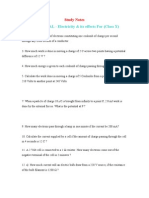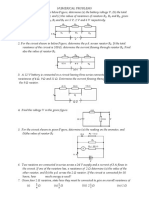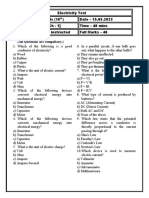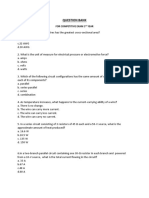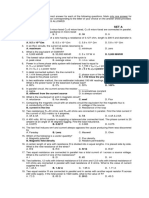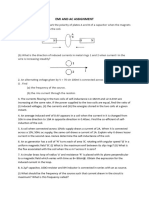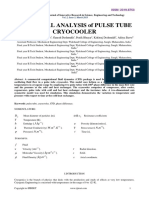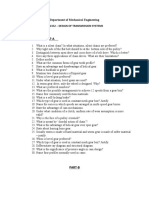Chapter 19 Electric Circuits: Name
Chapter 19 Electric Circuits: Name
Uploaded by
Timothy KurbyCopyright:
Available Formats
Chapter 19 Electric Circuits: Name
Chapter 19 Electric Circuits: Name
Uploaded by
Timothy KurbyOriginal Description:
Original Title
Copyright
Available Formats
Share this document
Did you find this document useful?
Is this content inappropriate?
Copyright:
Available Formats
Chapter 19 Electric Circuits: Name
Chapter 19 Electric Circuits: Name
Uploaded by
Timothy KurbyCopyright:
Available Formats
CHAPTER 19 ELECTRIC CIRCUITS
Name:
QUESTIONS
19.2 Electric currents
1. What is the current flowing through a section of wire if 2.0 C of charge passes through it
in 5 seconds?
2. How many electrons move through a conductor every second if they produce a 3 A
current?
3. How many electrons will move through the cross-section of a wire in an 8 second period
of time if the wire has a current of 1 A?
19.3 Resistors and resistance
4. A 30 cm length of wire has a resistance of 1.6 Ω. How much resistance will a 90 cm
length of wire have that is cut from the same roll of wire?
5. What will be the resistance of a 2 m length of nichrome wire if it has a diameter of
1 mm?
6. A 4 m length of wire has a cross-sectional area of 1 × 10–3 m2 and a resistance of
60.0 μΩ.
(a) Calculate the resistivity of the metal the wire is made from.
(b) What metal is the wire made from? (Use table 19.1.)
19.4 Power supply
7. Calculate the amount of electrical potential energy given to 2 μC of charge by a 12.0 V
battery.
8. (a) How much current passes through a 6 Ω resistor if there is a potential drop of 2 V
experienced by charges moving through it?
© John Wiley & Sons Australia, Ltd 1
QUEENSLAND PHYSICS
(b) How much heat energy is dissipated when 4 μC of charge has passed through the
resistor?
9. How large is the resistance of a conductor which allows a current of 2 A to pass through
it when a potential difference of 10 V is placed over it?
19.5 Series and parallel circuits
10. Consider the circuit shown at right.
(a) Calculate the current through the 2.50 Ω resistor.
(b) Calculate the current through the 6.00 Ω resistor.
(c) Calculate the voltage drop across the 6.00 Ω resistor.
(d) Calculate the voltage gain across the power supply.
11. For the circuit shown at right, calculate:
(a) the current in the circuit
(b) the voltage drop across the 20.0 Ω resistor
(c) the voltage drop across the 15.0 Ω resistor.
12. For the circuit shown at right, calculate:
(a) the current through the 4.00 Ω resistor
(b) the current through the 8.00 Ω resistor
(c) the current through the power supply.
13. For the circuit shown below, calculate:
(a) the voltage drop across the 10.0 Ω resistor
(b) the voltage drop across the 20.0 Ω resistor
(c) the current through the 20.0 Ω resistor
© John Wiley & Sons Australia, Ltd 2
QUEENSLAND PHYSICS
(d) the current through the power supply.
14. Calculate how many 20.0 Ω resistors, connected in parallel to a 2.00 V power supply,
would result in a current of 1.00 A through the power supply.
Review questions
Understanding
1. Draw circuit diagrams showing a 12.0 V battery and resistors of 2.00 Ω, 4.00 Ω and
6.00 Ω:
(a) in series
(b) in parallel.
2. Define an electric current.
3. (a) Identify the charge carriers in a metal.
(b) Describe how these charge carriers move in a conductor under the influence of a
power supply.
4. Explain how heat energy is produced when an electric current passes through a metal.
5. Explain what is meant by the potential difference across the ends of a resistor.
6. A battery is marked 25 V. Explain what this means.
7. Explain what is meant by:
(a) a conductor
(b) a resistor
(c) an insulator.
8. Demonstrate by means of diagrams the correct way of connecting into a circuit:
(a) an ammeter
(b) a voltmeter.
© John Wiley & Sons Australia, Ltd 3
QUEENSLAND PHYSICS
Application
9. In the circuit shown below, the current through the 4.00 Ω resistor is 5.00 A. Calculate:
(a) the current through the 8.00 Ω resistor
(b) the current through the power supply.
10. In the circuit shown below, the current through the power supply is 6.00 A and the
current through R1 is 4.00 A.
(a) Calculate the current through R2.
(b) Deduce which resistor has the greater resistance.
11. A current of 2.00 A is flowing through a wire.
(a) Calculate how many coulombs pass through a cross-section of the wire in 3.00 s.
(b) Calculate how many electrons pass through a cross-section of the wire in this time.
12. An electric current is flowing through a wire. A charge of 4.20 C passes through a cross-
section of the wire in 3.00 s. Calculate the current in amps.
13. A current flows through a wire for 2.50 s. During this time 5.60 × 1018 electrons pass
through a cross-section of the wire.
(a) Calculate the charge passing through a cross-section of the wire in this time.
(b) Calculate the current in amps.
14. When 2.50 C pass through a certain resistor, 50.0 J of heat energy is generated. Calculate
the potential difference across the resistor.
15. The potential difference across a certain resistor is 32.0 V. Calculate how much heat
energy is produced when 12.0 C of electric charge passes through the resistor.
16. Calculate the change in electric potential energy as 2.00 C of charge passes through a
2.50 V battery.
17. When a current of 2.00 A passes through a certain resistor there is a potential difference
of 16.0 volts across it. Calculate the resistance of the resistor.
© John Wiley & Sons Australia, Ltd 4
QUEENSLAND PHYSICS
18. A coil of wire has a resistance of 3.20 Ω. Calculate the potential difference across the coil
when there is a current of 2.00 A passing through the coil.
19. The following table refers to the potential difference V across a resistor of resistance R
when a current I passes through it. Calculate the values of the missing quantities and
complete the table.
20. You are given four pieces of wire made of the same material. The lengths and diameters
of the wires are given in the following table. List these in order of increasing resistance.
Justify your answer.
21. In the circuit shown at top right, the current through the 6.00 Ω resistor is 4.00 A.
Calculate the current through each of the 3.00 Ω resistors.
22. In the circuit shown below, the power supply has a voltage of 20.0 V and the voltage drop
across the 6.00 Ω resistor is 12.0 V. Calculate the voltage drop across each of the 2.00 Ω
resistors.
23. In the circuit shown below, the voltage drop across the 5.00 Ω resistor is 20.0 V.
Calculate:
(a) the voltage drop across the 8.00 Ω resistor
(b) the voltage of the battery.
24. For the circuit shown below, calculate:
(a) the total resistance
(b) the current through the power supply
(c) the potential drop across the 12.0 Ω resistor.
25. When a certain resistor is connected to a 25.0 V power supply, the current through the
resistor is 12.5 A. Calculate the resistance of a second resistor, connected in series, that
reduces the current to 5.00 A.
26. In each of the following cases, calculate the total resistance.
(a) Resistors of 12.0 Ω and 16.0 Ω in series
(b) Resistors of 12.0 Ω and 4.00 Ω in parallel
© John Wiley & Sons Australia, Ltd 5
QUEENSLAND PHYSICS
(c) Resistors of 12.0 Ω, 10.0 Ω and 17.0 Ω in series
(d) Resistors of 12.0 Ω, 10.0 Ω and 17.0 Ω in parallel
(e) Six 15.0 Ω resistors in series
(f) Five 2.00 Ω resistors in parallel.
27. For the circuit shown below, calculate:
(a) the potential drop across the 12.0 Ω resistor
(b) the potential drop across the 4.00 Ω resistor
(c) the current through the 4.00 Ω resistor
(d) the potential gain across the power supply
(e) the current through the power supply.
28. For the circuit shown below, calculate:
(a) the current through the 25.0 Ω resistor
(b) the current through the 15.0 Ω resistor
(c) the current through the power supply.
Challenges
29. Consider the circuit shown below. Determine:
(a) the total equivalent resistance R that would replace all of the resistors in the circuit
without changing the value of I
(b) the value of I
(c) the value of I2
(d) the potential drop across the 8 Ω resistor.
© John Wiley & Sons Australia, Ltd 6
QUEENSLAND PHYSICS
30. (a) Given four 10 Ω resistors, how many different total resistances can be obtained by
placing them in varying combinations?
(b) What will be the highest resistance possible?
(c) What will be the lowest?
31. Determine the value on the ammeter in the following circuit.
32. Copper metal has about 1029 free electrons per m3 that act as charge carriers. What will be
the average velocity of the electrons in a copper wire if it has a radius of 2 mm and a
current of 2 A passing through it?
Notes:
© John Wiley & Sons Australia, Ltd 7
You might also like
- Year 11 Prelim Exams PhysicsDocument22 pagesYear 11 Prelim Exams PhysicsTimothy Kurby100% (1)
- Dt466-Dt570-Torque de Cabaza ValvuasDocument22 pagesDt466-Dt570-Torque de Cabaza ValvuasWero vences Alpargatas80% (5)
- 2.2 Resistance 91-03Document10 pages2.2 Resistance 91-03Murray PhysicsNo ratings yet
- Discussed in Full Class - Discussed With A3, A4 - Yet To Be DiscussedDocument6 pagesDiscussed in Full Class - Discussed With A3, A4 - Yet To Be Discussedvatsalshah240% (1)
- 01 Circle Theorems - 2 PDFDocument5 pages01 Circle Theorems - 2 PDFTimothy KurbyNo ratings yet
- Neighbours - Tim Winton - Australia PDFDocument3 pagesNeighbours - Tim Winton - Australia PDFTimothy KurbyNo ratings yet
- Controlling Inrush Current in High Demanding ApplicationsDocument10 pagesControlling Inrush Current in High Demanding ApplicationsFelipe MederosNo ratings yet
- NUMERICAL - Electricity & Its Effects For (Class X)Document6 pagesNUMERICAL - Electricity & Its Effects For (Class X)Gayathiri Suresh67% (3)
- NUMERICALS On Electricity-10Document5 pagesNUMERICALS On Electricity-10Tanmay Pandey100% (1)
- Series and ParallelDocument7 pagesSeries and ParallelSuryaveer bhatiNo ratings yet
- ADCExmpDocument10 pagesADCExmpgromit948No ratings yet
- Electricity Assignment HHWDocument5 pagesElectricity Assignment HHWAditya GoelNo ratings yet
- Electric NoteDocument6 pagesElectric NoteKucing GemukNo ratings yet
- Problem Set in ELE 001Document8 pagesProblem Set in ELE 001Patrick GarciaNo ratings yet
- Bee 14 Question BankDocument10 pagesBee 14 Question BankprakashkerurNo ratings yet
- Electricity TestDocument5 pagesElectricity Testsomnukp2001No ratings yet
- Ch12 Electricity Ohms Law and Combination of ResistorsDocument10 pagesCh12 Electricity Ohms Law and Combination of ResistorsHenisha ChodvadiyaNo ratings yet
- ElectricityDocument2 pagesElectricityyashasviupadhyay19No ratings yet
- Physics 40 Marks ch1Document3 pagesPhysics 40 Marks ch1Sanjay NayakNo ratings yet
- ch12 Class 10th Science AssignmentDocument2 pagesch12 Class 10th Science AssignmentPriyanka Kasturia100% (1)
- Question Bank EEDocument62 pagesQuestion Bank EECedric Jayme JordanNo ratings yet
- Worksheet X PhysicsDocument31 pagesWorksheet X PhysicsGuru PrasannaNo ratings yet
- Ohm - S LawDocument10 pagesOhm - S LawBela RilloNo ratings yet
- 12Document4 pages12Girma chalaNo ratings yet
- Ee1 Ece 500Document7 pagesEe1 Ece 500Karen Gale A. Lodia - AlarconNo ratings yet
- Achyuta Public School Electricity-Segment-1 Electric CurrentDocument6 pagesAchyuta Public School Electricity-Segment-1 Electric Currentavp sNo ratings yet
- JEE - Mains - Current - Electricity - Questions NewDocument8 pagesJEE - Mains - Current - Electricity - Questions NewcodeakashcodeNo ratings yet
- EE QuestionairesDocument7 pagesEE Questionairesivygrace gabestpaelmaoNo ratings yet
- Series and Parallel CircuitsDocument23 pagesSeries and Parallel CircuitsPrecious ChirangareNo ratings yet
- Circuits and Ohms Law2Document4 pagesCircuits and Ohms Law2Edu De LuqueNo ratings yet
- Company - Combined QuestionDocument29 pagesCompany - Combined Questionbe.ece.a.2021No ratings yet
- X ScienceDocument7 pagesX ScienceSanghamitra ChakrabortyNo ratings yet
- Chapter 35 Circuits and Ohms LawDocument4 pagesChapter 35 Circuits and Ohms Lawbhumika mehtaNo ratings yet
- Basic Electrical Engineering Question Bank-21EEE15ADocument18 pagesBasic Electrical Engineering Question Bank-21EEE15AG46Anand P KNo ratings yet
- 10th ElectricityDocument2 pages10th ElectricityBalmukund KumarNo ratings yet
- CircuitsDocument2 pagesCircuitsEn En BelthereNo ratings yet
- Easter End of Term 2023 ELE Exam G10Document3 pagesEaster End of Term 2023 ELE Exam G10Shivshankar ChaitramNo ratings yet
- Assignment 7Document2 pagesAssignment 7Pavan KhetrapalNo ratings yet
- Physics 1 1Document5 pagesPhysics 1 109 Ethan Ho Zehn Hee 何政希No ratings yet
- AC ws-1Document6 pagesAC ws-1sowmiasojanNo ratings yet
- Emi and Ac AssignmentDocument5 pagesEmi and Ac AssignmentMohammed AmmaarNo ratings yet
- Ohm - S LawDocument8 pagesOhm - S LawBela RilloNo ratings yet
- TUTORIAL 5 (Series Parallel)Document6 pagesTUTORIAL 5 (Series Parallel)Luthfi Bin LokmanNo ratings yet
- I. Choose The Correct Answer From The Given AlternativesDocument4 pagesI. Choose The Correct Answer From The Given AlternativesbunniabebeNo ratings yet
- Assignment of EeeDocument4 pagesAssignment of EeeHarshilNo ratings yet
- Tempat Belajar Infinite: Rukan Taman Meruya Blok M No. 75 Meruya Ilir Jakarta Barat 1Document5 pagesTempat Belajar Infinite: Rukan Taman Meruya Blok M No. 75 Meruya Ilir Jakarta Barat 1infinite onlineNo ratings yet
- Test 2Document16 pagesTest 2edwardNo ratings yet
- CH - 12 - Electricity - Assignment - 2021-22Document3 pagesCH - 12 - Electricity - Assignment - 2021-22Yash DawaniNo ratings yet
- Pre Board Exam ElexDocument10 pagesPre Board Exam Elexart16marasiganNo ratings yet
- DPP - Electricity (Prashant Kirad)Document12 pagesDPP - Electricity (Prashant Kirad)Abhinav Singh100% (2)
- Electricity QuestionsDocument11 pagesElectricity QuestionsSharvinder SinghNo ratings yet
- Unit 9 ExercisesDocument6 pagesUnit 9 Exercisesyooh9814No ratings yet
- ElectricityDocument2 pagesElectricityTanmay SanchetiNo ratings yet
- Electricity QuestionsDocument11 pagesElectricity QuestionsYuresh YNo ratings yet
- X Physics Segment 2 Q-BankDocument7 pagesX Physics Segment 2 Q-Bankavp sNo ratings yet
- Cheat Sheet 2-Physics 2Document2 pagesCheat Sheet 2-Physics 2AnanyaBandyopadhyayNo ratings yet
- 01 REFRESHER EE 1 - CLB - CompressedDocument12 pages01 REFRESHER EE 1 - CLB - CompressedJuphil PletoNo ratings yet
- Reference: University Physics by Sears, Zemansky and Young, Sixth Edition: Ch. 26Document4 pagesReference: University Physics by Sears, Zemansky and Young, Sixth Edition: Ch. 26Tanvir AhmedNo ratings yet
- Electricity - WorksheetDocument2 pagesElectricity - WorksheetGeetika KalraNo ratings yet
- 21498d689f43ad3001855bae328c5bbcDocument6 pages21498d689f43ad3001855bae328c5bbcmaterialstudy2400No ratings yet
- A1Document4 pagesA1Jules Nikko Dela CruzNo ratings yet
- Final Requirement IN EE320A/L: (Basic Electrical Engineering)Document25 pagesFinal Requirement IN EE320A/L: (Basic Electrical Engineering)Andre RoqueteNo ratings yet
- Ryan International School Class X Chapter: ElectricityDocument2 pagesRyan International School Class X Chapter: ElectricityAnnu ChaudharyNo ratings yet
- Tut Divide ProblemsDocument7 pagesTut Divide ProblemsTimothy KurbyNo ratings yet
- Eng STD - MOD C Text AnalysisDocument9 pagesEng STD - MOD C Text AnalysisTimothy KurbyNo ratings yet
- AERONAUTICAL Engineering HSC Online 49 Pgs VGDocument49 pagesAERONAUTICAL Engineering HSC Online 49 Pgs VGTimothy KurbyNo ratings yet
- Essay T S EliotDocument3 pagesEssay T S EliotTimothy Kurby100% (1)
- Billy Elliot Sample PageDocument9 pagesBilly Elliot Sample PageTimothy KurbyNo ratings yet
- Part 2 PP 18 - 31 Scene-By-scene CommentaryDocument14 pagesPart 2 PP 18 - 31 Scene-By-scene CommentaryTimothy Kurby100% (1)
- Physics 1 Torque Equation - TamDocument1 pagePhysics 1 Torque Equation - TamTimothy KurbyNo ratings yet
- Biology Happy Holiday HomeworkDocument3 pagesBiology Happy Holiday HomeworkTimothy KurbyNo ratings yet
- Maths Revision 2 UnitsDocument11 pagesMaths Revision 2 UnitsTimothy KurbyNo ratings yet
- PH2302 Homework 3 PDFDocument2 pagesPH2302 Homework 3 PDFYeo Jun YiNo ratings yet
- Serie VP-P StucchiDocument6 pagesSerie VP-P StucchiHIDRAFLUIDNo ratings yet
- Matlab ManualsDocument123 pagesMatlab ManualsKashaf TehreemNo ratings yet
- Performance and Evaluation of Ofdm and Sc-Fde Over An Awgn Propagation Channel Under RF Impairments Using Simulink at 60GhzDocument6 pagesPerformance and Evaluation of Ofdm and Sc-Fde Over An Awgn Propagation Channel Under RF Impairments Using Simulink at 60GhzelhoucineNo ratings yet
- E 28-Electrical Laboratory & Testing EquipmentDocument61 pagesE 28-Electrical Laboratory & Testing EquipmentShrikant KambleNo ratings yet
- Subject - Verb - AgreementDocument27 pagesSubject - Verb - Agreementthakursuryapratap6No ratings yet
- 11 Numerical AnalysisDocument9 pages11 Numerical Analysisعزالدين حسنNo ratings yet
- 10.1.2 Lab - Troubleshoot OSPFv3Document5 pages10.1.2 Lab - Troubleshoot OSPFv3joseNo ratings yet
- S2 Space March Test EditedDocument8 pagesS2 Space March Test EditedFatima Ahmed-VeriterNo ratings yet
- COMA 202 Final Paper Part 2Document19 pagesCOMA 202 Final Paper Part 2Lot VillegasNo ratings yet
- CIVIL-VII-PAVEMENT MATERIALS AND CONSTRUCTION NOTES - Part1Document29 pagesCIVIL-VII-PAVEMENT MATERIALS AND CONSTRUCTION NOTES - Part1Mohammed Abdul QuddusNo ratings yet
- Design of Transmission Systems - Important QuestonsDocument5 pagesDesign of Transmission Systems - Important QuestonsPost BoxNo ratings yet
- Updating To CAMEO 2.1 From A Previous Version of CAMEO: Phase 1: Before Installing CAMEO 2.1 - Exporting Your DataDocument5 pagesUpdating To CAMEO 2.1 From A Previous Version of CAMEO: Phase 1: Before Installing CAMEO 2.1 - Exporting Your DataA.cNo ratings yet
- PCBC TutorialDocument74 pagesPCBC Tutorialvelimier100% (1)
- Keyence Infrared Temperature Sensors BrochureDocument14 pagesKeyence Infrared Temperature Sensors BrochureAlfin AhsanNo ratings yet
- Hull Fund 9 e CH 05 Problem SolutionsDocument10 pagesHull Fund 9 e CH 05 Problem Solutionsnandkishore patankarNo ratings yet
- SCHULER, Robert M. An Alchemical Poem. Authorship and ManuscriptsDocument3 pagesSCHULER, Robert M. An Alchemical Poem. Authorship and ManuscriptsBruno Sousa Silva GodinhoNo ratings yet
- The Development of Multi-AxisDocument148 pagesThe Development of Multi-AxissyedabdulhannanNo ratings yet
- Xi Syllabus Half YearDocument2 pagesXi Syllabus Half YearAkshay SharmaNo ratings yet
- Practical Soy Sauce Production Using A Mixed Koji-Making SystemDocument3 pagesPractical Soy Sauce Production Using A Mixed Koji-Making SystemTâm Dương ĐứcNo ratings yet
- 14 - Technical Spec Document (TSD) For CSS IF Sys - v1.1 - 20210106Document53 pages14 - Technical Spec Document (TSD) For CSS IF Sys - v1.1 - 20210106Farhan hadistyNo ratings yet
- Max AnalyzerDocument2 pagesMax AnalyzerInstrulife OostkampNo ratings yet
- Trigonometry SheetbyomsirDocument12 pagesTrigonometry SheetbyomsiraryanNo ratings yet
- Waste Heat Recovery at Compressor Stations: The Path Towards Novel and High-Impact Technologies and Their ImplementationDocument33 pagesWaste Heat Recovery at Compressor Stations: The Path Towards Novel and High-Impact Technologies and Their ImplementationraaaghaffarNo ratings yet
- Ladder Diagram Smart Relay Lift Barang 4 LantaiDocument4 pagesLadder Diagram Smart Relay Lift Barang 4 LantaiYogo HaryantoNo ratings yet
- Kolej Matrikulasi Pulau Pinang: Unit MatematikDocument28 pagesKolej Matrikulasi Pulau Pinang: Unit MatematikComplicated Sangat SangatNo ratings yet
- 2015 JC2 H1 Maths Yishun Junior CollegeDocument15 pages2015 JC2 H1 Maths Yishun Junior CollegeHANSNo ratings yet
- One Dimensional Heat FlowDocument4 pagesOne Dimensional Heat FlowSerial SpyNo ratings yet







